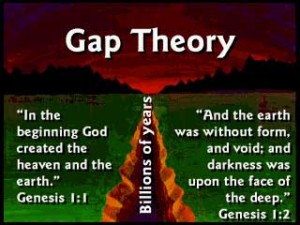
This is the second in a series about attempts to reconcile a supposed ancient earth (millions or billions of years old) with the Bible. One of these attempts is the Gap Theory, which after two centuries is still popular today, even among conservative Christians.
As mentioned in the first blog, by the end of the 18th century a number of scientists had proposed that the earth was millions of years old. In 1814, to reconcile these scientific conjectures with the Bible, Presbyterian minister Thomas Chalmers proposed what we call the Gap Theory or the Ruin-Reconstruction Theory. There are minor variations, but the theory generally holds that there was a large time gap between the first two verses of Genesis. During this gap in time, which could accommodate millions or billions of years, animals roamed the earth and a pre-Adamite race of men lived. At some point Satan rebelled against God and God judged the earth with a catastrophic flood, many call Lucifer’s Flood. This flood produced the fossils we see in the rock layers today. (Note: it is impossible that the fossils were laid down over millions of years before this time because Lucifer’s flood would have obliterated all traces of these fossils). Due to Lucifer’s Flood, the earth “became” ruined (“formless and void”) and then God “reconstructed” and “replenished” the perfect earth we have described in the rest of Genesis chapter 1.
There are a number of problems with this theory. First is the Hebrew grammar. The Bible begins with:
In the beginning God created the heaven and the earth. 2 And the earth was without form, and void; and darkness was upon the face of the deep…
Verse two begins with the conjunction “and”, which in the Hebrew is called a descriptive consecutive when it is followed by a noun (the earth). This means verse two begins by describing the earth (matter) that was created in verse one. There is no gap here.
Gappists also point to the phrase without form and void, used one other time in Jeremiah 4:23 and similarly when speaking of confusion and emptiness in Isaiah 34:11. Although both passages refer to divine judgment for sin, that is only gained from the context. A context of judgment on a pre-Adamic creation is nowhere found or implied in Genesis. Indeed, it is unwarranted to interpret an earlier verse in the Bible based on later context. In Genesis, from the context, the Bible is simply stating that God had created erets (Hebrew for earth, land, or matter – Gen 1:1), which He would later form into a beautiful spherical earth and fill it with plant and animal life and man. He created the earth and formed it to be inhabited (Isaiah 45:18).
Thirdly, gappists claim that the word replenish in verse 28 (in the KJV) supports the idea that the earth was once full and needed to be replenished. The fact is that when the KJV was translated, replenish simply meant to fill, just as the Hebrew word, male, means. The definition of replenish as being to fill again was not introduced until later.
Another reason to rule out “re-construction” of a ruined creation is that God clearly says in Exodus 20:11 He created everything in six days after which He pronounced that it was “very good” (Genesis 1:31).
For in six days the LORD made heaven and earth, the sea, and all that in them is, Exodus 20:11
Moreover, in Genesis 1 the Hebrew text is in a historical narrative structure (verb-subject-object). It is a description of events occurring on six sequential literal days. It is not poetic or figurative.
Probably the most important biblical truth which refutes the Gap Theory is the fact that death came only as a result of Adam’s sin. Romans 5:12 says:
Wherefore, as by one man sin entered into the world, and death by sin; and so death passed upon all men, for that all have sinned:
Adam’s sin not only corrupted the human race, but the entire creation. God told Adam “…cursed is the ground for thy sake;…” (Genesis 3:17), and Romans 8:22 says:
For we know that the whole creation groaneth and travaileth in pain together until now.
There could not have been pain, disease, struggle and death among animals and a pre-Adamic race of men before Adam’s sin. This is the whole premise for the Gospel message. Sin brought death and Christ came to atone for that sin. Adam’s was not just a spiritual death. Sin also brought the curse of physical death to Adam and Jesus Christ had to die a substitutionary physical death and be resurrected physically to remove the curse.
Adam and Eve were the first people and there is an important parallel between the literal first Adam and the literal last Adam, Jesus Christ.
And Adam called his wife’s name Eve; because she was the mother of all living.
Genesis 3:20
And so it is written, the first man Adam was made a living soul; the last Adam was made a quickening spirit. 1 Corinthians 15:45
In conclusion, we need to simply take God’s Word as our final authority and not attempt to incorporate man’s theories. The Bible clearly says God finished His creation on the sixth day, culminating with Adam and Eve, and “everything” was “very good.” No hint of pre-Adamites, sin, rebellion, or death here.
So God created man in his own image, in the image of God created he him; male and female created he them…31 And God saw every thing that he had made, and, behold, it was very good. And the evening and the morning were the sixth day. Genesis 1:27, 31





Thank you for such a clear and understandable explanation of the Gap theory. I completely agree that we need to simply take God’s Word as our final authority and not attempt to incorporate man’s theories. Well said!